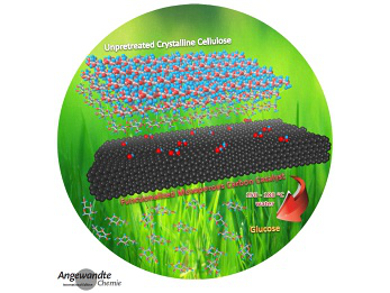In this issue, H. Haick et al. review hybrid volatolomics and disease detection. How can volatile organic compounds be identified in biological cells? In a Minireview, E. Balaraman et al. discuss catalyzed hydrogen-transfer annulations as a means to access heterocyclic scaffolds. The Highlight deals with host materials for sulfur cathodes (H.-J. Peng and Q. Zhang). M. Daub and H. Hillebrecht contribute a Correspondence article on the structure of perovskite phases, and A. K. H. Hirsch summarizes the symposium that was recently held to commemorate the achievements of Nobel Laureate J.-M. Lehn’s group.
In the Communications section, A. Katz et al. show how weak-acid sites catalyze the hydrolysis of crystalline cellulose to glucose (see picture). E. P. Balskus et al. succeeded in the biosynthesis-assisted structure elucidation of chlorinated glycolipids from cyanobacteria. J. Mack et al. found an inexpensive and recyclable catalyst for the cyclopropanation of alkenes, and W. Schnick et al. obtained rare-earth-metal nitridophosphates through high-pressure metathesis.
- Angewandte Chemie 38/2015: Volatility and Confinement,
Angew. Chem. Int. Ed. 2015, 54 (38).


